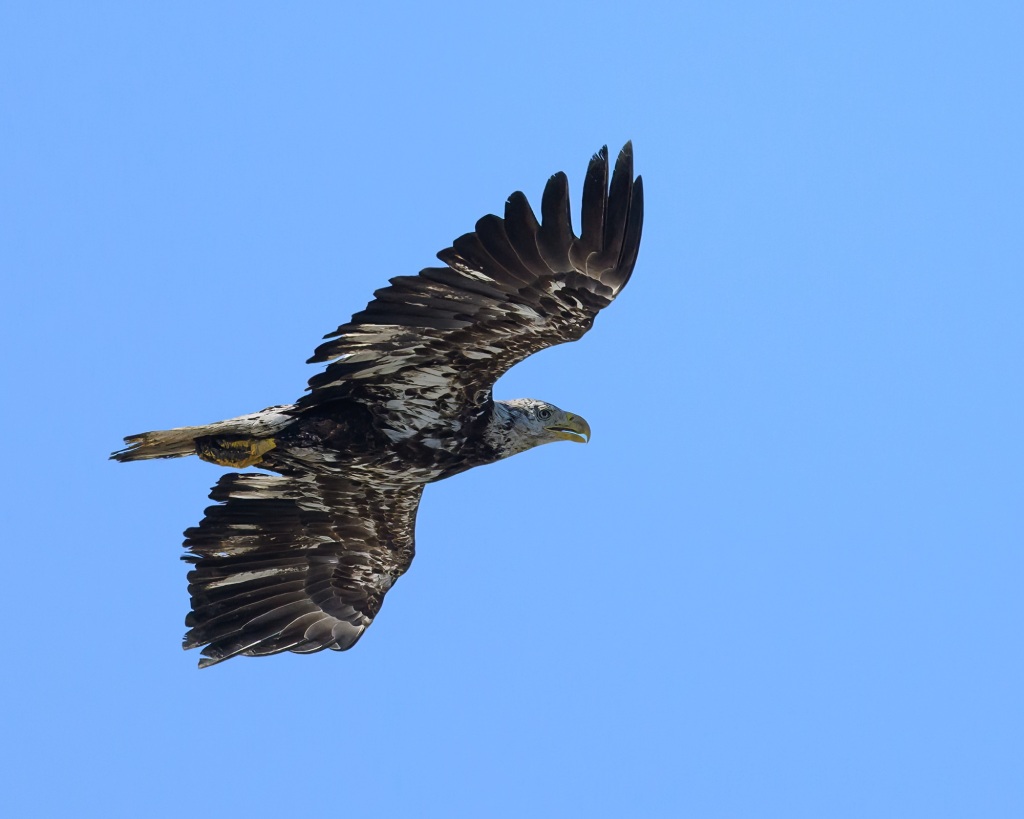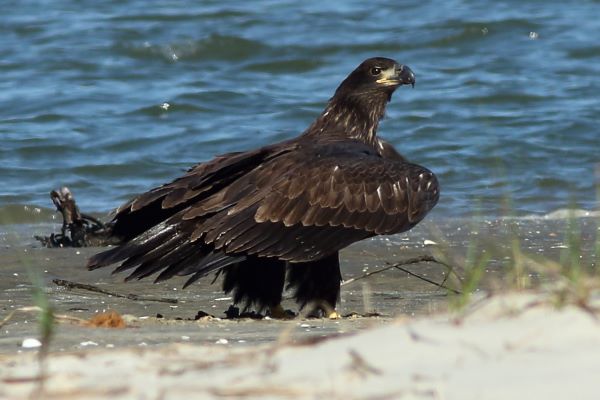Question: I recently photographed a Bald Eagle on North Beach, and while I know it’s not yet an adult, how can I tell the age of this eagle?
Gina Sanders

Answer:
An adult Bald Eagle is unmistakable! They are big, fly with a flat wing (flying plank is how it is sometimes described), sport huge schnoz, and display their bright white head and tail. With a quick look, young Bald Eagles can be readily identified by size, shape, flight pattern, and especially the well-endowed beak.
Young Bald Eagles create an interesting challenge for someone who wishes to put the bird into a specific age grouping. For starters, it takes the average Bald Eagle 4 to 5.5 years to reach maturity. During that time, they will molt all or some of their feathers usually twice a year, though some individuals skip a molt. That gives us many different patterns depending upon age and season.
To make life a little easier, in this blog, I focus on the five (5) basic plumages (the plumage held on the longest). I point out some key features to look for as you study a bird, especially one overhead.
Juvenile or first year bird

Sitting on the ground, the juvenile Bald Eagle just out of the nest is very dark. Note how black the head is. Who can miss that beak?
Overhead, the bird is still dark with a variable amount of white in the wings and on the body. Note the dark head and the straight, clean, trailing edge of the wing.

Immature second year bird

By the second year, the birds have molted some of their wing feathers giving the trailing edge a ragged look. The belly and head are lighter, yet the face is still dark especially around the auricular (area covering the ears). The whitish tail ends in a black terminal band.
Immature third year bird
For the third-year birds, the ragged trailing wing edge indicates the bird still experiences a staggered flight feather molt. With this phase the head begins to lighten up and it appears the bird sports a bold white eyeline above its dark face. The amount of white on the body diminishes and the belly appears darker like the throat.

Immature fourth year bird

By the fourth year, the head is substantially white, but the bird still supports white flecking on its body and the tail had not turned white, yet.
Almost an adult
Technically adults, these two birds still show some brown flecking on the head and white in the body. They have not yet completed their molt to the classic adult pattern.

Adult

Some birds develop quicker and reach adulthood in 4 years, but most will take up to 5.5 years to take on the classic Bald Eagle pattern. Since a Bald Eagle may live for 25 to 35 years, they can take their time reaching sexual maturity.
Judging from the amount of white remaining in the body and wings, and the amount of white on the head, we can estimate that the eagle you saw is between its third and fourth year.
Like anything in birding, good observation reveals important information. Since Bald Eagles nest on Seabrook Island, birders may find eagles in every phase of growth. From now on, look closely to see if you can estimate the age of one of those eagles flying overhead.
To learn more about the life history of Bald Eagles, visit Cornell Lab: “All About Birds”
Answer and Photos by: Bob Mercer
References:
Buehler, D. A. (2022). Bald Eagle (Haliaeetus leucocephalus), version 2.0. In Birds of the World (P. G. Rodewald and S. G. Mlodinow, Editors). Cornell Lab of Ornithology, Ithaca, NY, USA. https://doi.org/10.2173/bow.baleag.02


